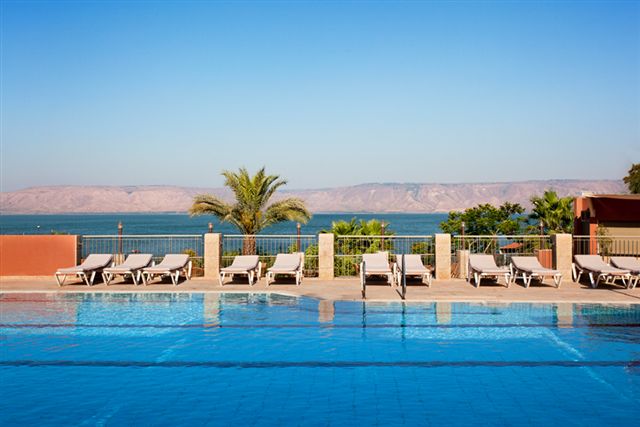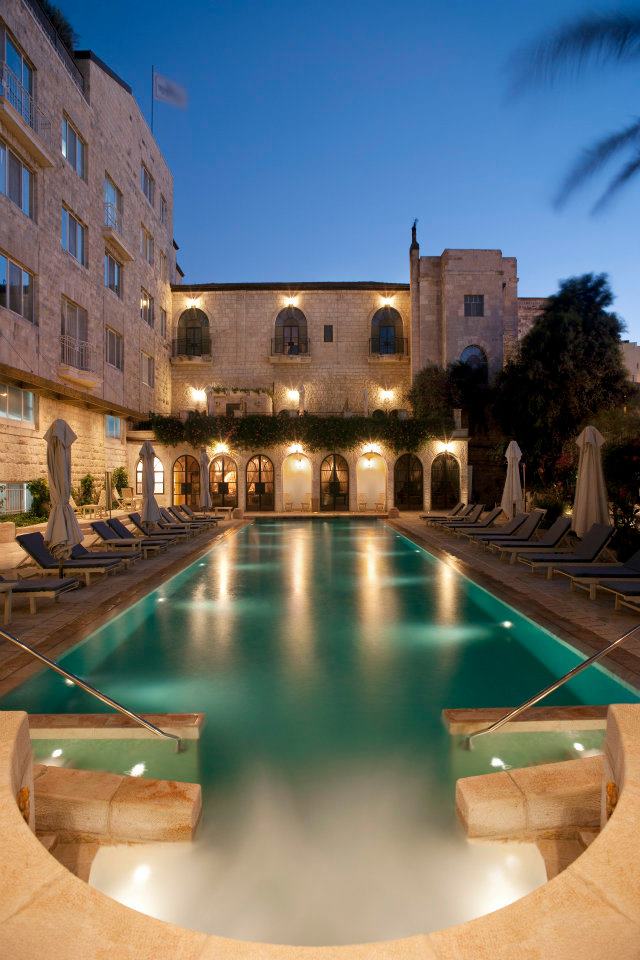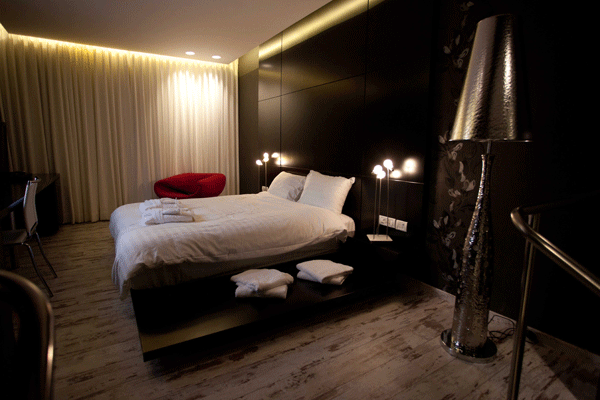1.Scots Hotel, Tiberius
The castle-like
Scots Hotel building was constructed as a hospital in the 19th century by Scottish surgeon, Dr. David Watt Torrance. His son took over from him and continued treating the sick in the hospital until his retirement in 1953. It continued to be a maternity hospital until 1959 when it was converted into a guesthouse. The Church of Scotland has been in Tiberius since 1885 but only built its first church in 1930. As a Christian Dr.Torrance integrated prayer in the life of the hospital and on Sundays worship took place in the waiting rooms and wards. A few years after the hospital closed the building was refurbished as a Hospice for pilgrims; in 2004 after complete refurbishing the Church of Scotland opened the hotel in the Scottish Hospital compound. Although being modernized to incorporate luxurious amenities visitor can still enjoy the basalt stone building and historic architecture. Today the hotel welcomes guests of all faith.
There is a large outdoor swimming pool with a garden leading down to the edge of
the Sea of Galilee. There are 16 luxury rooms which have been decorated and restored to the original 19th century look. They have high ceilings and exposed basalt stone walls. The Deluxe Rooms have a Scottish flavor but together with the “Unique Rooms” they are modern. In the hotel art gallery you can see rotating exhibitions by local artists of all faiths. The hotel has several fine dining eateries and an excellent luxury spa.

2.Drisco Hotel, Tel Aviv
This hotel is located in Tel Aviv’s American Colony (which later became known as the German Colony) one of the city’s first neighborhoods and one of the first hotels outside
Old Jaffa. The American Colony was established by a group of American Protestant Evangelicals who arrived from Maine in 1866. The group was led by George J. Adams, founder of the Church of the Messiahs. The group believed in strengthening ties with the Jews in order to hasten the coming of the Messiah. The group bought land north of Jaffa and built houses out of wooden pre-fab parts brought from America. The hotel was built in 1866 by the brothers John and George Drisco. The Drisco brothers were among the group of American settlers and they wanted to help make the colony a haven for pilgrims. They bought land and built their hotel naming it Le Grand Hotel. However it was not too successful and so they sold it to a German missionary, Peter Martin Metzler who turned it into a mission for Swiss-German pilgrims. Metzler sold the hotel in 1869 to Christopher Hoffmann and George David Hardegg, leaders of the Temple Society (Templers). The hotel was then named The Jerusalem Hotel was run by Ernst Hardegg, George David Hardegg’s Son. Many dignitaries and famous people stayed at the hotel including Mark Twain and Thomas Cook. The hotel operated from 1870 to 1940. During the Second World War the hotel was used as British Military Headquarters.
The newly renovated hotel’s design has retained the spirit of the turn-of-the-century sophistication but has modern amenities and modern luxury. The hotel has 50 luxury suite rooms. From the hotel roof top terrace there are 360° views of the city and views of the sea. On the ground floor there is a recreated authentic Turkish hamam where guests can get pampering treatments. The hotel restaurant is in the cellar.
The Drisco Hotel is set to welcome its first guests in June 2017; in the meantime Tel Aviv has several other historic hotels including the Market Hotel; Rothschild Hotel; Old Jaffa Hostel and the Boutique Hotel Montefiore.
3.The American Colony Hotel, Jerusalem
The original hotel building was constructed in the 19th century by the Paha Rabah Effendi el Huseini on the remains of a former Ottoman building (part of which can still be seen in the hotel restaurant). The American Colony was formed by a group of Christian Americans who came to the Holy Land to live the simple life and do good deeds among Christians, Jews and Arabs. The “Americans” as they came to be known, were joined by a group of Swedes and soon formed a tight knit community. They rented the building from Huseini and eventually bought it in 1895 and opened a guesthouse for visitors of all faiths. Today the hotel complex includes several buildings – the original main building; a new wing; the Palm House; the East House and the Cow Byre.
The New Wing’s architectural style is in keeping with the original building. Today each floor in the New Wing has a different theme (Swedish, Spafford, Allenby, TE Lawrence etc). the main building of
the hotel is the original structure and holds the lobby, reception, cellar bar, restaurants, fitness area and business center. In addition there is the Palm House, a two story building from the end of the 19th century. Here the rooms have brilliant ceiling mural and there is a beautiful garden courtyard where the hotel holds summer barbeques. The East House is another structure within the hotel complex; it was build c.1870 by the Pasha and adjoins a unique edible garden. The East House has arched ceilings and a different patterned tile floor in each room. The top floor is a luxurious penthouse suite. The Cow Byre is another of the historic hotel buildings which still has the original exposed ceiling beams and stonework. The hotel complex has several picturesque courtyards and vine covered patios.

4.Efendi Hotel, Acre
This hotel is housed in two adjacent Efendi houses which once served as palaces for Ottoman rulers. The hotel overlooks the narrow lanes of the Old City of Acre. The palaces were built on the remains of Byzantine 6th century and Crusader 12th century structures. The northern house is thought to have been built in 1768 by a Greek Catholic family. In the 18th century an olive oil soap factory inhabited the lower part of the house. In 1870 the house was rebuilt and renovated into “The Palace.” The building has intricate murals, ornamental plaster work and marble floors. At the end of the Ottoman Era the houses were abandoned and left vacant for many years. In 2001 restoration began on The Palace and the adjacent Afifi House. Many artists and artisans were employed to restore the building to its former glory. Students of the School for Historic Preservation in Venice worked together with local artists on the ceiling murals and décor. Each room is individually decorated and furnished. The rooms feature artistic décor, murals and pieces of furniture created from reclaimed preserved wood. Most of the rooms have sea views. The hotel has 12 rooms with modern conveniences without sacrificing the enchanting authentic atmosphere.
5. Templers Hotel, Haifa
Nestled at the foot of
the Baha’i Gardens is an historic
neighborhood called the German Colony. The buildings of the German Colony have one or two storey stone buildings, many dating back 100 years and cobbled streets. This is where you can find
the Templers Hotel. The Templers were a group of Protestant Christians who were expelled from the church in 1858 and came from Germany to Israel to recognize their dream of rebuilding the Temple which they believed would bring about the second coming of Christ. They established several colonies in Israel in Serona, Tel Aviv; Galilee, Jerusalem and the Haifa German Colony in 1868.
The Temple Hotel is in the heart of the German Colony and was one of the first buildings constructed in the colony in 1870. The hotel interiors have been decorated with a blend of the old and new; east and west. Each of the hotel’s 13 rooms has a balcony facing the street. The hotel also has three luxury studio rooms. The public areas of the hotel include beautiful inner courtyards. Visitors can experience the original stone building in the public areas and each of the guest rooms has been given an individual character and theme. Some of the rooms have private patios shaded by lush vegetation and trees and others have private balconies. Most of the rooms are very modern but there are also those which have retained beautiful tile floors and traditional wooden shutters. The Zodiac Room has a free standing bath, terracotta-color tile floor and exposed brick walls.
